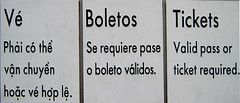The following post was provided to us by Margaret Austin Smith. Thanks, Margaret! :)
“I actually liked this book,” reports J. walking in to our second class meeting, his copy ofGang Leader for a Day in hand. His classmates agreed. They’d gobbled it up overnight and were full of thoughts about Sudhir Venkatesh and the folks in the community of theRobert Taylor Homes where he studied. Our first reading of the term, Venkatesh’s book presents a novel-esque account of the relationship between gang and community in a public housing building in Chicago. As a graduate student in Sociology, he set out to study race and poverty with a survey: “How does it feel to be poor and Black?” A.) Good B.) Somewhat Good C.) Bad D.) Very Bad. In the words of economist Stephen Leavitt(Freakonomics), he found out the real answer was E.) F— you!
As Venkatesh tells it, his first visit to the Robert Taylor home leaves him stranded in a stairwell over night, held hostage by gang footmen who think he’s an infiltrator from a rival “Mexican” gang. Only when the gang leader, JT, arrives and finds the grungy grad student non-threatening is he allowed to leave. Venkatesh goes home, grabs a nap, and heads back later that day.
Why does he go back? He could have died! What was he thinking? Why did they let him go? The one sweet young man who raises his hand to say: Shouldn’t it be illegal for him to put himself in that much danger? His classmates chewed him up for that one. But my students are demanding answers, and perhaps if I could sing, I would tell them that Jay-Z has already addressed the same question: “I’m a hustler baby, I just want you to know…”
JT–the leader with whom Venkatesh briefly switches places to become the eponymous gang leader for a day–becomes Venkatesh’s point of entry into the community. Heading up a branch of a local institution-like gang, JT is a college-educated, former scholar athlete with a head like an Excel spreadsheet for keeping accounts that can’t be recorded on paper. My students – like Venkatesh – identify with him, sympathize with him even when they tried to resist doing so. Like Venkatesh, they are sheepish and hurt when we read about JT engaging in some of the more violent duties of his job: auditing (with his fists) residents whose economic activities are not properly authorized by the gang; marketing gang life to 14-year old boys with rolls of cash for them to spend and then pay back at elephantine interest rates (functionally making them indentured servants of the gang).
What my students are most struck by, however, is the sense of community among residents in this building of the Robert Taylor Homes. Residents act as police, plumbers, security guards, electricians, counselors, day-care providers, janitors, foster parents–and they take on these roles without formal pay checks, without contracts, without legal recourse should their jobs turn dangerous. What is clear to us is that there is an economy that operates outside the formal (legal) economy but operates much in the same way as that legal economy–and that these economies are embedded in the community in which they are operating. (Victory, Karl Polanyi! Economy is embedded in society!)
The students are receptive to — and eager for — more discussion about how informal economies operate. Why do some people get shut out from the formal economy? Shouldn’t supply and demand create positions for them–especially if much of what happens in the informal economy mirrors the work that’s done every day in the formal economy (child care, TV repair, car washes, clean-up, infrastructure, rent-collection, etc.)? Is it because they live in public housing that they cannot get formal jobs in which they could sue if they got hurt and demand pay checks when they did not get paid?
We try to address some history of public housing: we listen to Part 1 of Venkatesh’s radio documentary on the Robert Taylor Homes in class. Public housing was, at one time, a solution–it provided people with a safe and trustworthy alternative to paying exorbitant sums to seedy tenement landlords. It provided people with clean, dry living spaces that were not also occupied by farm animals. The people moved out of barns, out of slums, and into public housing moved into homes and into hope. So when, my students ask, did public housing stop being a solution and start being a problem?
Yet even after this discussion, in which N. was an active and thoughtful participant, he wonders in his written reflection assignment:
“Questions that must be asked have to do with the intended purpose of the Robert Taylor housing project and its actual effects on its residents. In what ways was this funded project looking to help people? Which of its intended purposes are not being accomplished and why? I believe it is very clear that the state of this project the way Sudhir is observing it first hand is not a positive thing for any of its inhabitants and is damning to any person involved with it. The fact that the condition Robert Taylor is in can be reached by a state sponsored public housing setting must make us rethink the role of public housing, if public housing can be a positive thing for the well-being and happiness of citizens, and if so how? How must it be accomplished differently from the way Robert Taylor is run?
“Let’s observe from this book some of those conditions. Sudhir observes a community in which the public safety of the community is trusted to a gang that’s purpose is to sell crack cocaine by any legal or illegal means necessary. Children are exposed daily to all manner of illegal activity. Police and other government officials are not trusted and are even resented. If there is a physical emergency an ambulance is not trusted. 90% of the people within this community are living on state sponsored welfare which most of them are not looking to as a temporary solution to their economic situation. Now let’s ask why this building was built and why thousands of people call it home. In what ways was this situation intended to be different? Why is it a complete failure which is damaging to humanity. I believe in striving toward the betterment of society and most importantly the families and individual people it is composed of. I believe that if what Mr. Venkatesh is writing resembles the true occurrences of that project, it’s a shame it was ever built.”
His classmate, T, who had described in class growing up in public housing responds:
“I think you raised a good question of why are the projects such a failure to the idea of government aid to low income blacks in America. I think one of the biggest issues things like public housing offer are the fact that it doesnt offer these individuals a chance for advancement. For example, when you look at a place like the Robert Taylor homes. They are located in a bad area where schools are bad, no big businesses are located around there, if you want a job go to the local corner store or liqour store where they most likely wont hire you. For many young males around that area the gang life offers some stability for these people and their families. The government doesn’t open up any doors for this people yet wonder why they can’t provide for themselves. I believe this to be one of the major problems with public housing.”
Any suggestions for encouraging and furthering this discussion?
Attached here are some slides we used during our discussion about the robert taylor homes, including a chart from a warm-up exercise we did on discourse about public housing. In groups of 3-4, students were asked to make a two-column list, on one side noting things they’d heard about public housing and on the other side noting where they’d heard it from. I encouraged them to cite specific movies, books, rap songs, advertisements, etc., but they were very hesitant to do so. They mostly cited the book we were reading as their source for what they’d heard about public housing. Most students said they didn’t know or hear anything about public housing beyond what we’d looked at in this book. If I try this activity again, I think I will ask them to come up with a list of the other names by which public housing may be known and then ask them to approach the discourse activity from a view including all of those names. “Public housing” may have just seemed too formal for them to make the connections with what I am sure they DO see and hear in music, media, culture, ads, etc….Any thoughts?
Resources
Polanyi, Karl. 1944/2001. The Great Transformation. Boston: Beacon.
Venkatesh, Sudhir. 2008. Gang Leader for a Day. New York: Penguin.






